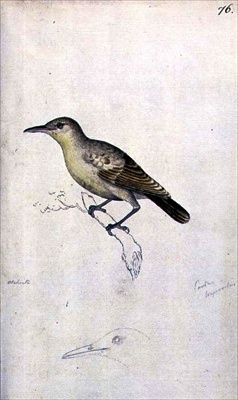Moorea reed warbler facts for kids
Quick facts for kids Moorea reed warbler |
|
|---|---|
 |
|
| Painting by William Ellis | |
| Conservation status | |
| Scientific classification | |
| Genus: |
Acrocephalus (bird)
|
| Species: |
longirostris
|
| Synonyms | |
|
|
The Moorea reed warbler (Acrocephalus longirostris) is a small songbird. It belongs to a group of birds called Acrocephalus, which are often known as marsh warblers. This bird was once thought to be a type of Tahiti reed warbler, but now it is seen as its own unique species.
Where It Lives
The Moorea reed warbler is only found on the island of Moorea. This island is part of the Society Islands in the Pacific Ocean. These birds live in forests that are growing back after being cut down. They also like areas with thick groups of a plant called Polynesian 'ohe, which is a type of bamboo. They likely build their nests and raise their young in these bamboo thickets. You can find them in river valleys and on hillsides.
What It Looks Like
This bird can appear in two different colors. One type is a light color, which is pale yellow with brownish spots on its back. The other type is a dark color, which is olive-brown all over.
Conservation Status
The Moorea reed warbler was last officially seen in 1987. For a long time, people worried it might have disappeared completely. This was because its home was being destroyed. Things like building hydroelectric power plants and new roads harmed its habitat. Also, people were cutting down too much bamboo, which the birds need.
Another big problem was the arrival of new plants and animals that were not native to the island. These are called invasive species. For example, the miconia tree grew very fast and took over the birds' natural home. Other animals like the common myna (a type of bird) and feral cats also caused problems for the warblers.
However, there have been two possible sightings of the bird since 2000. These sightings give hope that the Moorea reed warbler might still be alive. It is probably living in very small numbers. Because of this, a study in 2018 suggested that the bird should be listed as "Critically Endangered." This means it is still in great danger, but not necessarily extinct.


